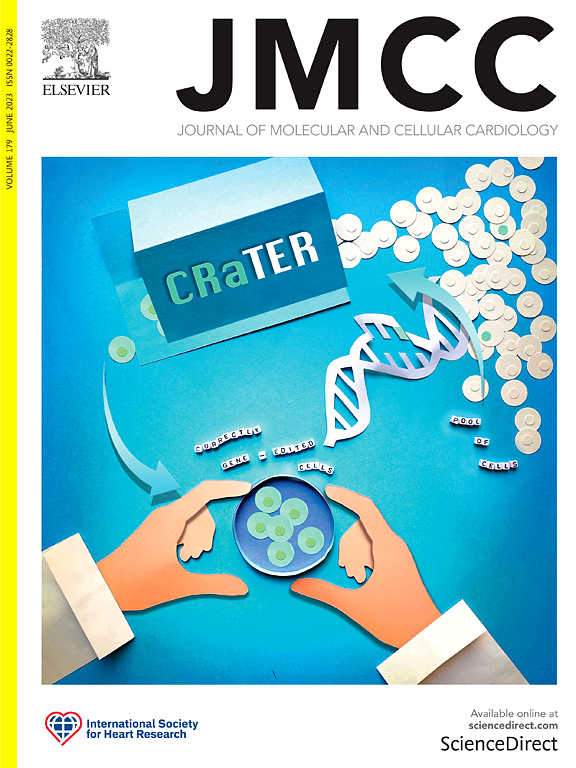FSTL1 protects against acute aortic dissection by suppressing vascular smooth muscle cell phenotypic switching and degradation of the extracellular matrix
IF 4.9
2区 医学
Q1 CARDIAC & CARDIOVASCULAR SYSTEMS
引用次数: 0
Abstract
Acute aortic dissection (AAD) is a life-threatening cardiovascular emergency, which is closely related to the vascular smooth muscle cells (VSMCs) phenotypic switching and extracellular matrix (ECM) degradation. Previous studies have found that the secreted extracellular glycoprotein Follistatin-like 1 (FSTL1) is demonstrated as a protective factor for cardiovascular diseases. However, the role of FSTL1 in AAD remains elusive. We aimed to investigate whether FSTL1 could regulate VSMCs phenotypic switching and ECM degradation in AAD. Firstly, we found that FSTL1 expression in aorta was significantly decreased in human AAD examined by western blot and immunohistochemical staining. Then we established a mouse AAD model by administering β-aminopropionitrile (BAPN) dissolved in drinking water for 28 days. We found that FSTL1 expression in aorta was also decreased in mouse AAD. Exogenous supplement with recombinant human FSTL1 protein could rescue VSMCs phenotypic switching and ECM degradation to reduce the occurrence and progression of mouse AAD. In vitro, FSTL1 protein and adenovirus overexpressing FSTL1 (ad-FSTL1) reversed the primary VSMCs phenotypic switching and decreased the expression of MMP2 induced by PDGF-BB. Knocking down FSTL1 initiates VSMCs phenotypic switching and increases the expression of MMP2. In terms of mechanisms, AMPK phosphorylation was decreased and could be improved by FSTL1 protein in mouse AAD. FSTL1 protein and ad-FSTL1 reversed the decreased AMPK phosphorylation induced by PDGF-BB in primary VSMCs. These findings indicate that FSTL1 protects against VSMCs phenotypic switching and ECM degradation in AAD, and targeting FSTL1 may be a potential new strategy for prevention and treatment of AAD.

FSTL1通过抑制血管平滑肌细胞表型转换和细胞外基质降解来防止急性主动脉夹层。
急性主动脉夹层(AAD)是一种危及生命的心血管急症,与血管平滑肌细胞(VSMCs)表型转换和细胞外基质(ECM)降解密切相关。先前的研究发现分泌的细胞外糖蛋白卵泡抑素样1 (FSTL1)被证明是心血管疾病的保护因子。然而,FSTL1在AAD中的作用尚不明确。我们的目的是研究FSTL1是否可以调节AAD的VSMCs表型转换和ECM降解。首先,通过western blot和免疫组化染色,我们发现AAD患者主动脉中FSTL1的表达明显降低。然后给药于饮用水中溶解β-氨基丙腈(BAPN) 28 d,建立小鼠AAD模型。我们发现AAD小鼠主动脉FSTL1表达也降低。外源性补充重组人FSTL1蛋白可以挽救VSMCs的表型转换和ECM降解,从而减少小鼠AAD的发生和进展。在体外,FSTL1蛋白和过表达FSTL1的腺病毒(ad-FSTL1)逆转了PDGF-BB诱导的原发性VSMCs表型转换,降低了MMP2的表达。敲低FSTL1启动VSMCs表型转换,增加MMP2的表达。在机制上,小鼠AAD中,AMPK磷酸化水平降低,FSTL1蛋白可改善AMPK磷酸化水平。FSTL1蛋白和ad-FSTL1逆转了PDGF-BB诱导的原发性VSMCs中AMPK磷酸化的下降。这些研究结果表明,FSTL1可以防止AAD中VSMCs表型转换和ECM降解,靶向FSTL1可能是预防和治疗AAD的潜在新策略。
本文章由计算机程序翻译,如有差异,请以英文原文为准。
求助全文
约1分钟内获得全文
求助全文
来源期刊
CiteScore
10.70
自引率
0.00%
发文量
171
审稿时长
42 days
期刊介绍:
The Journal of Molecular and Cellular Cardiology publishes work advancing knowledge of the mechanisms responsible for both normal and diseased cardiovascular function. To this end papers are published in all relevant areas. These include (but are not limited to): structural biology; genetics; proteomics; morphology; stem cells; molecular biology; metabolism; biophysics; bioengineering; computational modeling and systems analysis; electrophysiology; pharmacology and physiology. Papers are encouraged with both basic and translational approaches. The journal is directed not only to basic scientists but also to clinical cardiologists who wish to follow the rapidly advancing frontiers of basic knowledge of the heart and circulation.
文献相关原料
公司名称
产品信息
索莱宝
G1100
索莱宝
G1340
索莱宝
S2110
索莱宝
Hematoxylin-eosin staining kit
索莱宝
Masson staining kit
索莱宝
Mounting medium and antifading

 求助内容:
求助内容: 应助结果提醒方式:
应助结果提醒方式:


